What is the “seed bank”? It’s the reserve of viable seeds present in your soil surface or mixed with your soil at different depths. There are also other vegetative propagules that can contribute to increase your weed infestations such as tubers, solons etc.
How can we reduce our seedbank? When we fallow the fields during the summer preemergence herbicides can be applied with good results because weeds geminate after irrigations or rain.
The chart here shows that summer weeds germinate starting February-March and peak germination is in June and in some cases, they continue germinating until October.

Preemergence herbicides are often used for fallow weed control only when at least 30 -45 days or longer are available1. We must take into consideration most preemergence herbicides last about 3 months depending on soil conditions. Others like Eptam may last only like 3-4 weeks because of volatility2.
Also contact herbicides like Paraquat (Gramoxone, Firestorm), Carfentrazone (Aim, Shark), Pyraflufen (ET), Pelargonic Acid (Scythe) and others are used. These products act quick and leave little or no residual but must be applied when weeds are not too large. The systemic used most frequently is still Glyphosate. It has no residual and is broad spectrum herbicide. Another product registered for fallow use is Oxifluorfen (Goal, Galigan).
Another method used for lowering the seed bank in the summer is “Solarization”. Transparent polyethylene is effective for heating the soil. It is sufficient 4-6 weeks for satisfactory control of most weeds. Some weeds are very sensitive to solar heating of the soil. Sweet clover because of hard seeds and Nutsedge because of the tubers are hard to kill with solarization. Also, Bermuda because of the rhizomes is not easy to control.
Another method is water to germinate and kill weeds mechanically or with herbicides. Some weeds like Common purslane have succulent stems and can survive after cultivation. They could re-root from the nodes and produce seeds. Therefore, carefully monitor plants to uproot them small. Tillage has a negative effect on perennials such as nutsedge and Bermuda. By repeat irrigating and disking we really are spreading them instead of killing them.
References:
- https://cals.arizona.edu/crop/vegetables/advisories/more/weed236.html
- https://cals.arizona.edu/crop/vegetables/advisories/more/weed225.html
WEED DYNAMICS AS INFLUENCED BY SOIL SOLARIZATION - A REVIEW R.H. Patel, Jagruti Shroff, Soumyadeep Dutta and T.G. Meisheri, Anand Agricultural University, S A College of Agriculture, Anand - 388 110, India





